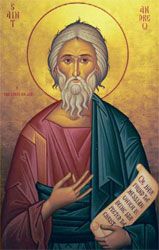 Andrew was a disciple of John the Baptist before becoming the first apostle to be called by Jesus. He was a Galilean and the brother of Simon Peter; in fact Andrew’s first and most significant act as Jesus’s follower was to look for his brother and bring him to Jesus.
Andrew was a disciple of John the Baptist before becoming the first apostle to be called by Jesus. He was a Galilean and the brother of Simon Peter; in fact Andrew’s first and most significant act as Jesus’s follower was to look for his brother and bring him to Jesus.
Andrew was present throughout the ministry of Jesus and played an important part in it. At the feeding of the five thousand, it was Andrew who told Jesus about the boy who had brought with him the loaves and fishes.
It is the Gospel of St. John in particular that tells us of Andrew’s contribution to the ministry of Jesus. Later traditions record that Andrew went on to preach to the Scythians or Greeks. In Greece he was so successful that at Patras he attracted the attention of the Roman proconsul, who ordered his execution. He had Andrew tied to a cross, not nailed, so that he would die more slowly. He is said to have lingered on the cross for two days before dying.
St. Andrew’s body was later taken by Constantine to Constantinople. St. Regulus, who was in charge of Andrew’s remains, was told by an angel in a dream to take them to a particular place; the angel would guide him. Regulus eventually arrived in Scotland, and the chosen spot was later known as St. Andrews. Regulus was helped by King Angus MacFergus, by tradition the founder of the town of St. Andrews. It was in this way that Jesus’s disciple became the patron saint of Scotland.
Feast Day: November 30
